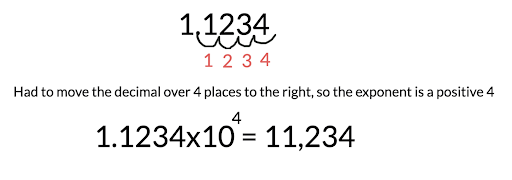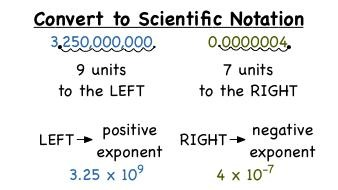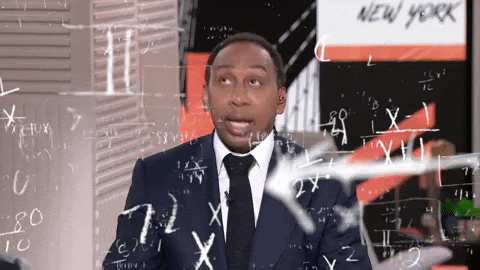
Scientific Notation
7 min read•december 6, 2021
Briana Dokken
Briana Dokken
How to Use and Convery Scientific Notation
What is Scientific Notation?
Are you taking high school science or math classes? Chances are, you'll run into scientific notation! Scientific notation is a practical, compact way to write numbers that are extremely small or big. If you are in a class that uses sig figs, writing numbers in scientific notation is also one of the easiest ways to communicate sig figs.
Have you ever seen a number written like these: 5.49 x 10^9, 2 x 10^2, and 4.899 x 10^-6? All of them are in scientific notation! When you write a number in scientific notation, you are putting one digit of a number in the ones place, the rest of the digits of that number will be after the decimal point. Then, you'll be multiplying that number by a power of 10 to show how big it is.

GIF courtesy of Giphy
How to Write a Number in Scientific Notation
You have one number in front of the decimal (1, 2, 3, 4, 5, 6, 7, 8, 9). 🐥
The rest of the numbers will go after the decimal. (Ex. .23456) 🤔
That number will be multiplied by a power of 10 (10^x) that makes it equal to the number you started with. (Ex. 123,456 in scientific notation = 1.23456 x 10^5) 💪
Scientific Notation in Action
Let's look at an example: How do we write 11,234 in scientific notation?
First, we put a decimal point after the first digit to get 1.1234.
Next, we figure out what power of 10 we have to multiply 1.1234 by to get 11,234. The easiest way to do this is by counting the number of spots the decimal has to move to get back.
To do this, put your pencil on the decimal in 1.1234, then move it until the number is 11,234.
3. Count how many times you had to move the pencil back, and that's the number you put "10 to the power of..." to the original number.

At this point, it's important to double-check if your exponent for the "10 to the power of..." should be positive or negative. ⚠️
If you started with a BIG number (something in the 100s, 1,000s, 10,000s, 100,000s, 1,000,000s, etc.), you should have a positive exponent. After all, your scientific notation number has to get bigger to match your original number). ➕
However, let's say you have a SMALL initial number (.1, .01, .001, .0001, .00001, etc.). In that case, you should have a negative exponent ("10 to the negative x") as you'd need to make the scientific notation number smaller to get back to your original number. ➖
Another way to figure out if your exponent should be positive or negative is by looking at which way you have to move your decimal point.
If you start with your number in scientific notation and move the decimal to the RIGHT to get to your original number, your exponent should be positive.
If you have to move the decimal to the LEFT, your exponent should be negative

Image Courtesy of Quizlet
Practice Problems!
Writing numbers in scientific notation may seem a little confusing at first, but it gets pretty easy after some practice. Try out a couple of these practice problems! 😉
Part 1: Write the Following Numbers in Scientific Notation
2,356
10,678
.000342
Part 2: Write the Following Numbers as regular numbers (take them out of Scientific Notation)
2.98 x 10^6
5.932 x 10^-2
7.7 x 10^-3
Order of Magnitude
Another term you might hear associated with scientific notation is order of magnitude. In a nutshell, "order of magnitude" refers to looking at whatever number is in the exponent spot of the 10 of the number in scientific notation. Not that intimidating, right? 😌
For example, if we had the number 7.39 x 10^5 and the number 3.489 x 10^3, we would say that the first number is 2 orders of magnitude greater than the second number (5 is 2 greater than 3)! ☝️
We can use order of magnitude to compare the size of numbers and also to make estimations and calculations. For example, 3.899 x 10^3 and 8.234 x 10^3 are 1) of the same order of magnitude and 2) are relatively similar numbers, while 5.589*10^7 is much bigger than those numbers because it is 4 orders of magnitude bigger (that means it’s at least 0,000x larger). 🪐
More Practice Problems!
Part 1: How many orders of magnitude greater is the first number?:
9.332 x 10^8 and 2.538 x 10 ^ 7
7.292 x 10^10 and 2.538 x 10 ^ 3
Part 2: Which number is most similar to the number 3.927 x 10^3? Why?:
10 x 10^4
9.3 x 10^17
14 x 10^6
Calculations with Scientific Notation
We can also use orders of magnitude to do calculations. Let’s say we want to divide 6.0 x 10^5 by 3.0 x 10^3. All we have to do is use the two numbers in front for the calculation (6 / 3 = 2), and then use exponent rules to figure out what the power of 10 for our answer should be. ✔️
Multiplication and Division
If you are multiplying two numbers that are multiplied by a power of 10, you can add the two exponents together, and this is the exponent that should be with 10 in your answer
If you are dividing two numbers that multiplied by a power of 10, you subtract the exponents to get the exponent that should be in your answer.
For our example, we take (6.0 x 10^5 divided by 3.0 x 10^3) 5 - 3 = 2 to get that our answer should be something times 10^2 (we subtract because we are dividing). ➗ ⇒ ➖
One thing to watch out for, though: it's important to note that sometimes the exponent will be negative! If we divided 3.0*10^3 by 6.0*10^5 instead, we would get our exponent to be -2. If you're ever unsure if the exponent should be negative or positive, remember that if you are dividing a smaller number by a bigger number, you should get a negative exponent because you should get a number smaller than one. 👍
Now we can put all of this together to get our answer: 2.0 * 10^2. We can double-check to see if this makes sense. In the beginning, we took 600,000 and divided it by 3,000 to get 200. Well, this makes sense! It’s helpful to double check your orders of magnitude using a method similar to this to make sure your answers are correct. 🔥
Addition and Subtraction
We can also add and subtract numbers of different (or similar) orders of magnitude when they are in scientific notation!
Add: Get the two numbers to the same order of magnitude, even if they are not written in correct scientific notation. If they already are the same order of magnitude, leave them as is. Add them together, and then fix the number so it’s in scientific notation. ➕
Example: (1.56 x 10^3) + (4.12 x 10^4).
Get them both in 10^4 by changing the first number to .156 x 10^4 (.156 x 10^4 = 1.56 x 10^3). You could also get both numbers to be 10^3 instead of 10^4, either way works.
Add the two numbers together (4.12 x 10^4) + (.156 x 10^4) to get your answer, 4.28*10^4. Sometimes, the number you get will not be in correct scientific notation (the decimal doesn’t come after the first digit), so make sure you double check and fix your answer if needed.
Subtraction: Do the same process as addition, but subtract your numbers instead of adding them. ➖
Example: (4.0 x 10^5) - (2.0 x 10^3) → (4.0 x 10^5) - (.020 x 10^5) = 3.98*10^5

GIF courtesy of Giphy
Even More Practice Problems!
Here are even practice problems on calculations (addition, subtraction, multiplication, division). If possible, do these without a calculator! 📱
(5.78 x 10^5) * (3.0 x 10^2)
(5.78 x 10^5) / (3.0*10^2)
(5.32 x 10^3) - (2.0*10^4)
(6.12 x 10^4) + (4.58 x 10^3)
Overall, scientific notation is a great way to express huge and tiny numbers. We can also use scientific notation to do calculations quickly. It can be a little tricky at first, but it makes writing numbers and doing calculations easier with some practice. You got this! 👌

Image courtesy of Reddit
💡 Studying for high school math or science and want to learn more beyond Scientific Notation? Find courses from statistics to physics to computer science on the Fiveable subjects page!
🤝Connect with other students studying Physics with Hours
Scientific Notation
7 min read•december 6, 2021
Briana Dokken
Briana Dokken
How to Use and Convery Scientific Notation
What is Scientific Notation?
Are you taking high school science or math classes? Chances are, you'll run into scientific notation! Scientific notation is a practical, compact way to write numbers that are extremely small or big. If you are in a class that uses sig figs, writing numbers in scientific notation is also one of the easiest ways to communicate sig figs.
Have you ever seen a number written like these: 5.49 x 10^9, 2 x 10^2, and 4.899 x 10^-6? All of them are in scientific notation! When you write a number in scientific notation, you are putting one digit of a number in the ones place, the rest of the digits of that number will be after the decimal point. Then, you'll be multiplying that number by a power of 10 to show how big it is.

GIF courtesy of Giphy
How to Write a Number in Scientific Notation
You have one number in front of the decimal (1, 2, 3, 4, 5, 6, 7, 8, 9). 🐥
The rest of the numbers will go after the decimal. (Ex. .23456) 🤔
That number will be multiplied by a power of 10 (10^x) that makes it equal to the number you started with. (Ex. 123,456 in scientific notation = 1.23456 x 10^5) 💪
Scientific Notation in Action
Let's look at an example: How do we write 11,234 in scientific notation?
First, we put a decimal point after the first digit to get 1.1234.
Next, we figure out what power of 10 we have to multiply 1.1234 by to get 11,234. The easiest way to do this is by counting the number of spots the decimal has to move to get back.
To do this, put your pencil on the decimal in 1.1234, then move it until the number is 11,234.
3. Count how many times you had to move the pencil back, and that's the number you put "10 to the power of..." to the original number.

At this point, it's important to double-check if your exponent for the "10 to the power of..." should be positive or negative. ⚠️
If you started with a BIG number (something in the 100s, 1,000s, 10,000s, 100,000s, 1,000,000s, etc.), you should have a positive exponent. After all, your scientific notation number has to get bigger to match your original number). ➕
However, let's say you have a SMALL initial number (.1, .01, .001, .0001, .00001, etc.). In that case, you should have a negative exponent ("10 to the negative x") as you'd need to make the scientific notation number smaller to get back to your original number. ➖
Another way to figure out if your exponent should be positive or negative is by looking at which way you have to move your decimal point.
If you start with your number in scientific notation and move the decimal to the RIGHT to get to your original number, your exponent should be positive.
If you have to move the decimal to the LEFT, your exponent should be negative

Image Courtesy of Quizlet
Practice Problems!
Writing numbers in scientific notation may seem a little confusing at first, but it gets pretty easy after some practice. Try out a couple of these practice problems! 😉
Part 1: Write the Following Numbers in Scientific Notation
2,356
10,678
.000342
Part 2: Write the Following Numbers as regular numbers (take them out of Scientific Notation)
2.98 x 10^6
5.932 x 10^-2
7.7 x 10^-3
Order of Magnitude
Another term you might hear associated with scientific notation is order of magnitude. In a nutshell, "order of magnitude" refers to looking at whatever number is in the exponent spot of the 10 of the number in scientific notation. Not that intimidating, right? 😌
For example, if we had the number 7.39 x 10^5 and the number 3.489 x 10^3, we would say that the first number is 2 orders of magnitude greater than the second number (5 is 2 greater than 3)! ☝️
We can use order of magnitude to compare the size of numbers and also to make estimations and calculations. For example, 3.899 x 10^3 and 8.234 x 10^3 are 1) of the same order of magnitude and 2) are relatively similar numbers, while 5.589*10^7 is much bigger than those numbers because it is 4 orders of magnitude bigger (that means it’s at least 0,000x larger). 🪐
More Practice Problems!
Part 1: How many orders of magnitude greater is the first number?:
9.332 x 10^8 and 2.538 x 10 ^ 7
7.292 x 10^10 and 2.538 x 10 ^ 3
Part 2: Which number is most similar to the number 3.927 x 10^3? Why?:
10 x 10^4
9.3 x 10^17
14 x 10^6
Calculations with Scientific Notation
We can also use orders of magnitude to do calculations. Let’s say we want to divide 6.0 x 10^5 by 3.0 x 10^3. All we have to do is use the two numbers in front for the calculation (6 / 3 = 2), and then use exponent rules to figure out what the power of 10 for our answer should be. ✔️
Multiplication and Division
If you are multiplying two numbers that are multiplied by a power of 10, you can add the two exponents together, and this is the exponent that should be with 10 in your answer
If you are dividing two numbers that multiplied by a power of 10, you subtract the exponents to get the exponent that should be in your answer.
For our example, we take (6.0 x 10^5 divided by 3.0 x 10^3) 5 - 3 = 2 to get that our answer should be something times 10^2 (we subtract because we are dividing). ➗ ⇒ ➖
One thing to watch out for, though: it's important to note that sometimes the exponent will be negative! If we divided 3.0*10^3 by 6.0*10^5 instead, we would get our exponent to be -2. If you're ever unsure if the exponent should be negative or positive, remember that if you are dividing a smaller number by a bigger number, you should get a negative exponent because you should get a number smaller than one. 👍
Now we can put all of this together to get our answer: 2.0 * 10^2. We can double-check to see if this makes sense. In the beginning, we took 600,000 and divided it by 3,000 to get 200. Well, this makes sense! It’s helpful to double check your orders of magnitude using a method similar to this to make sure your answers are correct. 🔥
Addition and Subtraction
We can also add and subtract numbers of different (or similar) orders of magnitude when they are in scientific notation!
Add: Get the two numbers to the same order of magnitude, even if they are not written in correct scientific notation. If they already are the same order of magnitude, leave them as is. Add them together, and then fix the number so it’s in scientific notation. ➕
Example: (1.56 x 10^3) + (4.12 x 10^4).
Get them both in 10^4 by changing the first number to .156 x 10^4 (.156 x 10^4 = 1.56 x 10^3). You could also get both numbers to be 10^3 instead of 10^4, either way works.
Add the two numbers together (4.12 x 10^4) + (.156 x 10^4) to get your answer, 4.28*10^4. Sometimes, the number you get will not be in correct scientific notation (the decimal doesn’t come after the first digit), so make sure you double check and fix your answer if needed.
Subtraction: Do the same process as addition, but subtract your numbers instead of adding them. ➖
Example: (4.0 x 10^5) - (2.0 x 10^3) → (4.0 x 10^5) - (.020 x 10^5) = 3.98*10^5

GIF courtesy of Giphy
Even More Practice Problems!
Here are even practice problems on calculations (addition, subtraction, multiplication, division). If possible, do these without a calculator! 📱
(5.78 x 10^5) * (3.0 x 10^2)
(5.78 x 10^5) / (3.0*10^2)
(5.32 x 10^3) - (2.0*10^4)
(6.12 x 10^4) + (4.58 x 10^3)
Overall, scientific notation is a great way to express huge and tiny numbers. We can also use scientific notation to do calculations quickly. It can be a little tricky at first, but it makes writing numbers and doing calculations easier with some practice. You got this! 👌

Image courtesy of Reddit
💡 Studying for high school math or science and want to learn more beyond Scientific Notation? Find courses from statistics to physics to computer science on the Fiveable subjects page!
🤝Connect with other students studying Physics with Hours

Resources
© 2024 Fiveable Inc. All rights reserved.
AP® and SAT® are trademarks registered by the College Board, which is not affiliated with, and does not endorse this website.